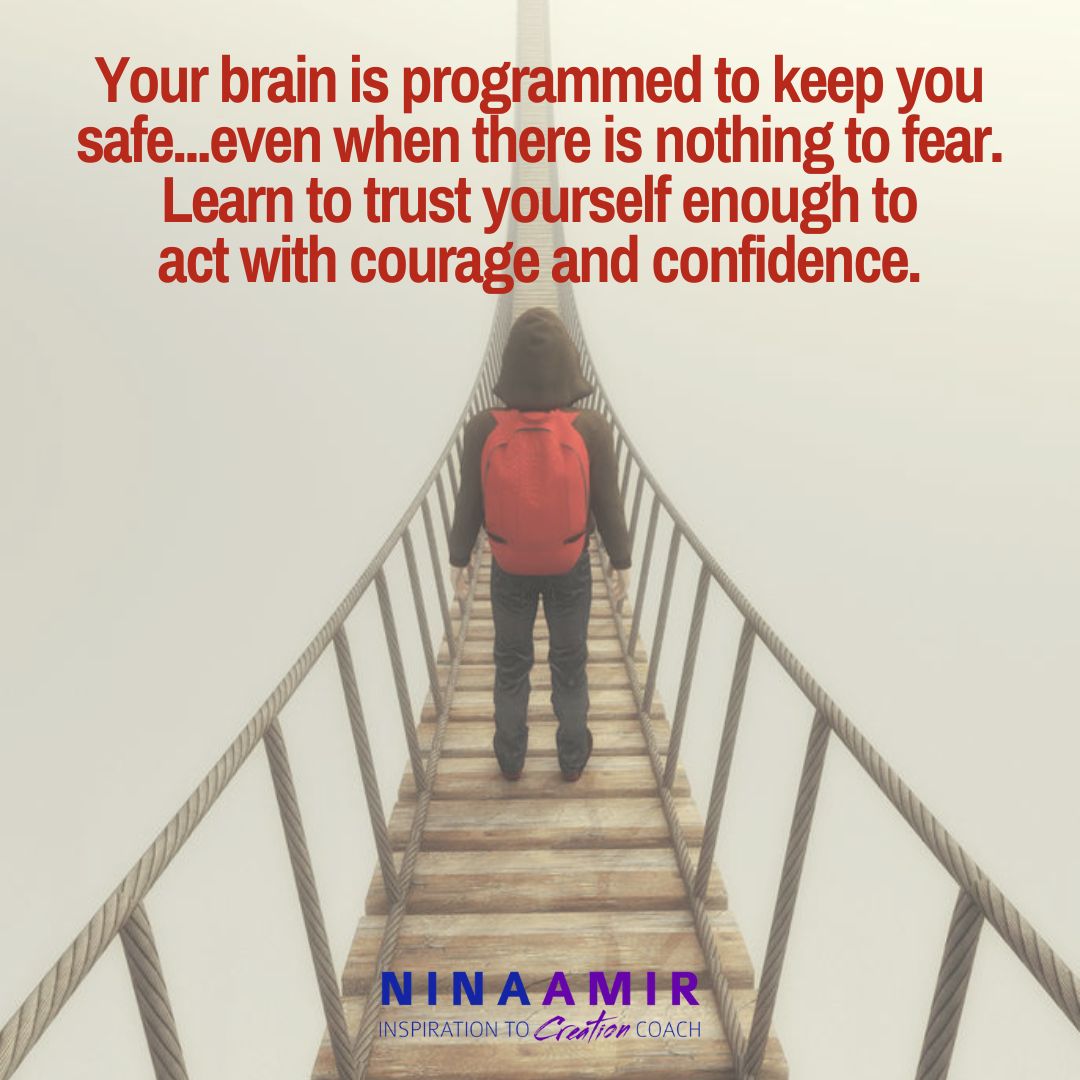Fear is a natural and instinctual brain-based response designed to protect you from physical harm, like the attack of a mountain lion. Unfortunately, the brain also perceives any change as a physical threat—even a different haircut, a new habit, or an investment in a personal growth program.
That’s when fear becomes a barrier preventing you from pursuing your goals, experiencing life fully, and stepping outside your comfort zone.
In such cases, you actually have nothing to fear. Your brain tells you you should be afraid because it is programmed to do so.
That’s when your thoughts turn to future negative potentialities—the things that could go wrong or feel uncomfortable—if you take a new action. Your mental chatter says doing something new or different is scary, so you feel disinclined to make any changes, even those that would benefit you.
Instead, you opt for safety—real or imagined—over fear.
The Relationship Between Courage and Confidence
Such a decision lowers your confidence level. You don’t feel able to take bold action. You can’t courageously go after your dreams, do what’s necessary to achieve your goals, or even get a new haircut or start an exercise routine.
After all, a confident person can move through fear. They have the internal feeling or belief that they can rely on themselves. They trust themselves and their decisions and actions, and they possess self-assurance arising from their knowledge and appreciation of their own abilities or qualities.
A courageous person tends to be a confident person. When you learn to overcome fear, your confidence level increases. Each time you don’t listen to your brain and, instead, affirm and trust that your new action is safe and take action, you create proof that being courageous won’t result in physical harm. As a result, your confidence grows.
Before discussing ways to overcome fear and become more confident, it’s helpful to understand how the brain creates fear.
How the Brain Creates Fear
Fear is created and processed in the brain in a fascinating and complex process that involves various regions and pathways.
Amygdala Activation
The amygdala is often referred to as the “fear center” of the brain. When a perceived threat is detected, sensory information is relayed to the amygdala, also called the “reptilian brain,” which evaluates the potential danger.
The amygdala triggers the body’s fight-or-flight response, activating physiological reactions such as increased heart rate and the release of adrenaline.
Thalamus and Sensory Processing
The thalamus acts as a relay station for sensory information. It quickly processes incoming stimuli, like sight or sound, before sending it to the amygdala for an emotional response. This enables rapid reactions to threats, sometimes even before you are fully conscious of them.
Cortex and Higher Processing
The prefrontal cortex is responsible for higher-level thinking and decision-making. It assesses the situation and can either reinforce or inhibit the fear response based on the context.
If the cortex determines that the threat is real, it amplifies the fear response. Conversely, if the threat is deemed non-existent, the cortex helps calm the amygdala.
Hippocampus and Memory
The hippocampus plays a crucial role in forming memories about past experiences and contextualizing fear responses. It helps individuals learn from previous encounters with danger, enabling them to recognize and remember threats in the future.
This function explains why you bring past memories of fearful situations into the present and believe you will experience them in the future.
Neurotransmitters and Hormones
Various neurotransmitters, such as dopamine and serotonin, and hormones, including cortisol and adrenaline, are involved in the fear response. These chemicals affect mood, arousal, and the body’s readiness to respond to threats. They are released when the brain perceives danger.
Conditioned Fear Responses
Fear can be learned through conditioning when neutral stimuli become associated with fear-inducing events. This is commonly studied in behaviorism (think Pavlov’s dogs) and explains why specific phobias develop.
For example, if you were bitten by a dog as a child, you might have become conditioned to fear all dogs even as an adult.
Neuroplasticity and Fear
The brain’s ability to change over time is called neuroplasticity. This ability allows you to overcome fears through exposure therapy or other techniques.
By reconditioning responses, you learn to manage or diminish the fear responses or triggers associated with them. For example, if you move through your fear of heights on several occasions, you develop new neural pathways that tell your brain heights are safe.
Rational Versus Irrational Fears
As you now realize, fear is a critical survival mechanism. Understanding how the brain processes fear offers insights into overcoming irrational fears and anxieties.
And most of your fears are just that—irrational. They are not real fears.
A real, rational fear arises from a lion running toward you, barring its teeth.
A false, irrational fear arises from thoughts that your new haircut will cause you physical harm. Rationally, you know it won’t. You might not like it. Others might criticize you for it. But you will not be harmed physically or die.
There might be a historical context for your fear, though. For example, as a teenager, you cut your hair and dyed it without your parents’ permission. When they saw you, your mom berated you for your actions, and your dad slapped you and sent you to your room for making a poor decision.
You now have an irrational fear that this will happen again if you cut or dye your hair—even though your parents are dead. You might subconsciously believe that someone else might do something similar, and this stops you from even entertaining the thought of a new hairstyle.
Clearly, the brain doesn’t always discern actual danger in the present moment. However, you can work with the brain to make the irrational fears go away.
Seven Ways to Overcome Fear
Whether your fear is of failure, spiders, rejection, public speaking, or the unknown, the key to overcoming these feelings lies in understanding and managing them effectively.
Here are seven powerful ways to confront your fears head-on. As a result, you will feel more confident and courageous.
1. Acknowledge Your Fears
Start by identifying what you fear. Make a list of them.
Sometimes, simply acknowledging and naming your fears can diminish their power over you. Acknowledging them helps you stop trying to ignore or negate them, which can exacerbate the issue.
Gaining clarity on what you’re afraid of provides a starting point for overcoming the fear. Then, you can try to uncover and understand the root of your fear, which allows you to address it directly.
For example, if you fear public speaking, uncover the reason why. Is it the fear of forgetting your words and feeling embarrassed? Or is it a fear of judgment?
If you can identify your fear of public speaking as “the fear of being judged,” you can strategize how to combat this fear instead of avoiding the situation altogether.
2. Reframe Your Thoughts
Fear comes from a focus on thoughts of negative potentialities. You place your attention on past events and assume you will experience the same fear or harm in the future.
Since you are the thinker of your thoughts, you can choose what to think about. When you stop placing your attention on fearful outcomes and focus your thoughts on positive, safe ones, you reduce your fear significantly.
In personal growth circles, coaches often ask clients considering doing something scary, “If you do it, will you die?” The client almost always responds, “No.” After they take the action, the person realizes nothing bad happened…despite all that time spent ruminating on adverse outcomes. This begins the process of reprogramming the brain.
This process, known as “cognitive reframing,” is a technique used to change negative thought patterns into more positive ones. The method identifies and challenges unhelpful or distorted thoughts, replacing them with more realistic and positive perspectives. When you view your fears from a more realistic perspective, you can diffuse them.
3. Practice Self-Compassion
Treat yourself kindly. Recognize that everyone experiences fear and self-doubt. Instead of being critical, encourage yourself as you would a friend.
That said, don’t give yourself too much grace. If your fears are irrational, encourage yourself to recognize them as such and develop the confidence to overcome them.
4. Visualize Yourself Being Courageous
Spend time visualizing yourself succeeding in overcoming your fears. Imagine yourself taking bold action, which is the definition of courage.
As you mentally see yourself overcoming your fear, you rewire your brain to believe you can be trusted to keep yourself safe. You also rewire it to see that the actions you want to take won’t harm you.
Keep this in mind: The brain cannot distinguish between what is real and what is imagined. It responds the same to your visualization of moving through fear as it does to you taking actual action to do so. That’s why visualization offers such a powerful tool for reprogramming the brain for less fear and more courage.
Hypnosis and self-hypnosis are also enormously effective tools. These methodologies help you visualize at a subconscious level, which negates some fears you may not realize impact your ability to take bold action.
5. Seek Support
Surround yourself with supportive people who can offer perspectives that you might not see on your own. A coach or group focused on helping you overcome fear and take bold action. Doing this work on your own can sometimes lead to failure and frustration, which does not embolden you or increase your confidence.
Many people who are afraid of public speaking join groups like Toastmasters. Seeing people with the same fear speak to the group increases members’ confidence that they can do the same. The people in the group understand and encourage others to get up on stage and speak.
6. Take Action
Fear can paralyze you, but taking even a small step in the direction of your goals creates momentum. Action breeds confidence.
Step out of your comfort zone regularly to practice being courageous. The more often you face your fears, the more confidence you’ll build over time.
Exposure therapy involves exposing someone to something they fear so they realize it is safe. Gradual exposure helps desensitize you to your fear, making it less powerful over time. Plus, you gain confidence as you face your fears in manageable increments.
While this process can be emotionally taxing and initially increase anxiety levels, it does work over time. And it also reprograms your brain.
You can do this work on your own. For instance, if you fear social interactions, start by making small talk with a cashier. Then progress to attending a social gathering and speaking to at least one person.
If you have a fear of heights, start with standing on a low stool. Gradually work your way up to visiting an observation deck of a tall building. Each step reinforces your ability to manage your fear and feel more comfortable and confident navigating higher elevations.
7. Practice Mindfulness and Relaxation Techniques
As you have learned, the body reacts to the brain’s determination that there is something to fear. But you can stop this physical process, thereby helping yourself feel less afraid and more confident.
Mindfulness reduces anxiety by focusing your awareness on the present moment. Self-compassion alleviates feelings of inadequacy, enabling you to face fears without harsh self-judgment.
Techniques like meditation, yoga, or deep breathing help you manage anxiety and ground yourself in the moment. It’s a simple practice to take deep breaths when you feel afraid. Try Dr. Andrew Weil’s 4–7–8 breathing method to calm yourself quickly.
Personal Growth: The Key to Overcoming Fear and Developing Confidence
An interplay exists between fear, confidence, and personal growth. After all, learning to move through your fears or to eliminate them involves the process of personal change.
The personal growth or personal development process is a lifelong journey of self-improvement focused on enhancing your potential, skills, and well-being so you can achieve a more fulfilling life. It involves a continuous cycle of self-awareness, goal setting, learning, and action to cultivate new capabilities and a better understanding of yourself. This process impacts all aspects of your life, including personal, spiritual, professional, and interpersonal relationships.
Many people pursue personal growth with a coach or in a group program because they want to become more courageous or confident. They seek to develop these characteristics and change their identities so they can be “someone courageous” or “someone confident.”
To overcome and develop confidence, focus on personal growth. Find a coach or program that can help you uncover and understand your fears and take confident and courageous action—despite feeling afraid.
Become a person able to go after your goals and dreams because you have trust in your ability to manage your thoughts and actions—despite your brain insisting it’s unsafe to do so. Be a courageous and confident person by overcoming your fears.
Do you have fears you need to overcome so you can confidently pursue your dreams and goals? Tell me why in a comment below. And please share this post with those who might benefit from reading it.
Image courtesy of orla.



